I was able to get a great solution to this problem with iScroll, with the feel of momentum scrolling and everything https://github.com/cubiq/iscroll The github doc is great, and I mostly followed it. Here's the details of my implementation.
HTML:
I wrapped the scrollable area of my content in some divs that iScroll can use:
<div id="wrapper">
<div id="scroller">
... my scrollable content
</div>
</div>
CSS:
I used the Modernizr class for "touch" to target my style changes only to touch devices (because I only instantiated iScroll on touch).
.touch #wrapper {
position: absolute;
z-index: 1;
top: 0;
bottom: 0;
left: 0;
right: 0;
overflow: hidden;
}
.touch #scroller {
position: absolute;
z-index: 1;
width: 100%;
}
JS:
I included iscroll-probe.js from the iScroll download, and then initialized the scroller as below, where updatePosition is my function that reacts to the new scroll position.
# coffeescript
if Modernizr.touch
myScroller = new IScroll('#wrapper', probeType: 3)
myScroller.on 'scroll', updatePosition
myScroller.on 'scrollEnd', updatePosition
You have to use myScroller to get the current position now, instead of looking at the scroll offset. Here is a function taken from http://markdalgleish.com/presentations/embracingtouch/ (a super helpful article, but a little out of date now)
function getScroll(elem, iscroll) {
var x, y;
if (Modernizr.touch && iscroll) {
x = iscroll.x * -1;
y = iscroll.y * -1;
} else {
x = elem.scrollTop;
y = elem.scrollLeft;
}
return {x: x, y: y};
}
The only other gotcha was occasionally I would lose part of my page that I was trying to scroll to, and it would refuse to scroll. I had to add in some calls to myScroller.refresh() whenever I changed the contents of the #wrapper, and that solved the problem.
EDIT: Another gotcha was that iScroll eats all the "click" events. I turned on the option to have iScroll emit a "tap" event and handled those instead of "click" events. Thankfully I didn't need much clicking in the scroll area, so this wasn't a big deal.

